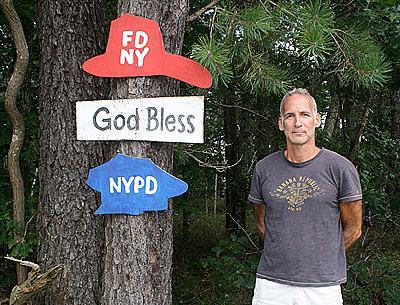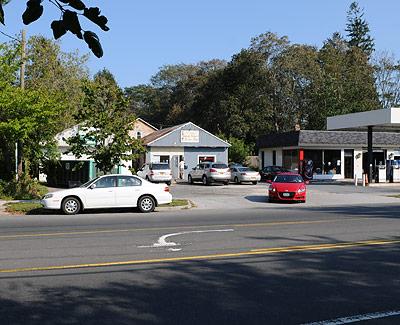Peter Van Scoyoc: Surprises in East Hampton
Peter Van Scoyoc: Surprises in East Hampton

Marked by a humble demeanor, a passion for Montauk’s wild beauty, and a local lineage that dates back to the 1700s, Peter Van Scoyoc is making his first serious bid for elected office as a town board candidate on the Democratic ticket.
Although Mr. Van Scoyoc ran for a trustee position in 1991 and has served a combined 11 years on the East Hampton Town Zoning and Planning Boards, he said, “I’ve always checked politics at the door. During all the time, I’ve never really been politically involved other than a political appointment so to speak. I’ve never run for office other than as a trustee.”
He was asked to run again in 1993, but his second child, Thomas, had just been born, joining his daughter, Amy, who was 2 at the time. He had just built a new house and was still running his residential construction business. His plate was decidedly full.
Eighteen years later, Mr. Van Scoyoc, who has now been on the planning board for six years, said that he felt compelled to run in this election because there were a number of choices and directions taken by the current Republican administration that he feels do not align with the public’s agenda. “My take on the pulse of the community is that things were getting done that people didn’t want, and they weren’t being listened to.”
He has been surprised by the amount of positive support he has received. Campaigning, which he often does door to door on bicycle, has been “fun and stimulating,” he said.
“I’m not a big self-promoter, but I just have stepped out of myself in terms of standing out in front of the post office and talking to people I don’t know at all,” he said. “It’s kind of exciting.”
One of the most rewarding parts of these impromptu dialogues with strangers are the new perspectives he gains with each conversation, he said.
“It may be something you never thought of before and that’s a real asset that gets overlooked by the group we have now,” he said, speaking of the town board’s Republican majority.
Mr. Van Scoyoc’s family’s historic East Hampton connections were a catalyst in his interest in local affairs and politics. A Virginia native and one of four sons of an Episcopal minister, he had always been aware that he had family ties to East Hampton — his grandfather had published a three-volume genealogy — but it was a strange coincidence involving a certain house on Northwest Road that raised his family fascination to a fever pitch.
He and his wife, Marilyn Van Scoyoc, who grew up in the Stony Brook area, had been living in Rhode Island, where Mr. Van Scoyoc ran a construction business and she was a music professor at the University of Rhode Island. When the market crashed in 1989, Ms. Van Scoyoc lost her job.
“We stayed in Rhode Island for another year and struggled with the building business, but everything had shut down in terms of building. It was tough economic times.” His wife interviewed to be a band director at East Hampton High School during the regular director’s yearlong leave of absence.
When the couple came to East Hampton for her interview, they decided to grab a few sandwiches from Bucket’s Deli and take a drive “to nowhere in particular,” he said. Their drive led them to Northwest Road, where they spotted a little ranch house, the only one on the road in the middle of the woods, he recalled.
His wife got the job, and when the man she was replacing temporarily decided to retire, she stayed on, and still teaches music and manages the jazz, concert, and marching bands.
“When we got back to town, I said, ‘That ranch would have been a cool place to rent,’ ” Mr. Van Scoyoc said. And when they actually rented it, “the people said, ‘Well, out of curiosity, are you related to the Van Scoyocs buried in the backyard?’ ”
It turns out that Mr. Van Scoyoc’s ancestors had farmed more than 180 acres throughout the Northwest Woods area. The house he built in 1993 and still lives in today is on land that was part of the Van Scoyocs’ original homestead.
“There is so much early history and those traditions are still alive,” Mr. Van Scoyoc said this week. “The first European families to settle here are still well represented and that’s very special. The heart and soul of the area are still intact and it’s a big part of who we are as a community. I think people cherish that whether they have a direct connection to it or not.”
Mr. Van Scoyoc said that East Hampton, where 13th-generation farming and fishing families live beside billionaires, artists, and writers, has some of the most socioeconomically diverse population he can imagine anywhere.
A self-described lapsed fisherman, Mr. Van Scoyoc has had a captain’s license for 25 years and and takes charter clients out on two of his boats, a “traditional down-easter” he keeps in Montauk called Dreamcatcher, and an anonymous 25-footer in Sag Harbor “that caters to the sheltered waters” of that area.
“For the faint of heart and for small children, Sag Harbor is better, but for the sea-hearty there is Montauk. I have to say, that’s where my heart is,” he said. “The first fish I ever caught was a bluegill in a farm pond when I was 3 years old. Fishing allows a connection to another universe underwater. Suddenly it becomes tangible, emerging from the unknown, and I think that intrigued me. You never know what you’ll find.”
Back to talk of the campaign and the position he hopes to win in November, Mr. Van Scoyoc counted his time as an appointed member of the planning and zoning boards as an asset. “I have a lot of experience sitting and listening to people’s proposals and ideas and weighing them against the needs of the community,” he said.
If the current administration “took the ideas and presented them in a way that people could explore them, they could find out exactly what the support is on any particular issue,” Mr. Van Scoyoc said, adding that the Democrats “have a very different approach. You either push down or you lift up. And we’re lifting.”


